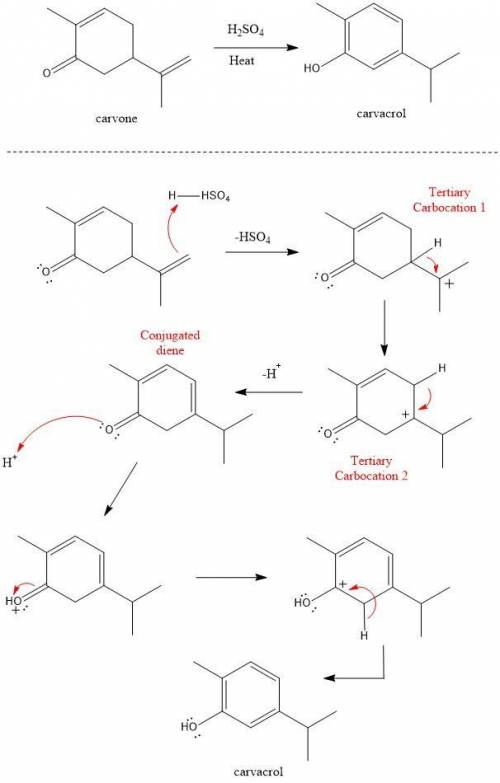
Chemistry, 30.07.2020 04:01 jadkins842
Heating carvone with aqueous sulfuric acid converts it into carvacrol. The mechanism involves the following steps:
1. The terminal alkene of carvone reacts with acid to form tertiary carbocation 1;
2. A hydride shift results in the formation of tertiary carbocation 2;
3. Deprotonation of the ring leads to conjugated diene 3;
4. Deprotonation at the α carbon leads to the product carvacrol.
Required:
Draw the mechanism and then draw the structure of tertiary carbocation 2.

Answers: 1


Another question on Chemistry

Chemistry, 22.06.2019 10:00
Suppose the universe were completely empty except for one object-a solid sphere moving through space of 100 km/s. what sort of path would the object be moving in? explain your answer
Answers: 1


Chemistry, 22.06.2019 21:50
Liquid from a brewery fermentation contains 10% ethanol and 90% water. part of the fermentation product (50,000 kg/h) is pumped to a distillation column on the factory site. under current operating conditions, a distillate of 45% ethanol and 55% water is produced from the top of the column at a rate of one-tenth that of the feed. what is the composition of the waste "bottoms" from the still?
Answers: 2

Chemistry, 22.06.2019 21:50
28. which is not a reason that water is used to store spent fuel rods from nuclear power plants? water increases the speed of the chain reaction in the fuel rods. water protects nuclear power plant workers from the high temperature and radiation of the fuel rods. water acts as a radiation shield to reduce the radiation levels. water cools the spent rods. salts action
Answers: 1
You know the right answer?
Heating carvone with aqueous sulfuric acid converts it into carvacrol. The mechanism involves the fo...
Questions

Chemistry, 27.06.2019 05:20



Mathematics, 27.06.2019 05:20


Social Studies, 27.06.2019 05:20


English, 27.06.2019 05:20




Mathematics, 27.06.2019 05:20




Computers and Technology, 27.06.2019 05:20








